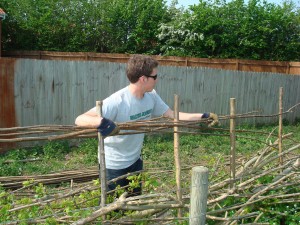On a warm and sunny Thursday morning, I made my way to the Norwich office of the British Trust for Conservation Volunteers (BTCV for short). I left my flat for the bus stop with plenty of time to arrive, but somehow I managed to get lost among the twisting and windy streets to the south of City Centre. Finally, I gave up and called the office to ask for directions. Tom was kind enough to find me a few yards away from the pathway that lead to the entrance, which was hidden behind thick brush. After signing a few forms, I made my way through the office to introduce myself to the other volunteers.
BTCV is a voluntary organization focused on conservation and education about environmental sustainability. Volunteers help to maintain parkland for public enjoyment, as well as working on landscaping tasks that raise funds for conservation efforts. In addition to working with volunteers who have learning disabilities, the trust offers career placement and volunteer opportunities for youth and the long-term unemployed.
At 930, ten other volunteers got into a van and headed toward the western end of the Bowthorpe housing subdivision, not far from the UEA village. Our task was based in a marshland that was purchased for preservation by the property developer, as a condition for the construction of the development. That day, our objective was to heather a fence along the edge of the marshland. Heathering is the creation of a fence in a decorative and aesthetically pleasing manner, achieved by weaving long branches in and out of stakes that are set in the ground. Our work wasn’t a conservation task, but was in exchange for funding from the local council that will be used to support our conservation efforts.
To start, we used a staking ram to drive the stakes into the ground, spaced at even intervals. We had to use the staking ram with two volunteers, one on each side. This was mainly to prevent injury, but also helped us keep the stakes at a ninety-degree angle with the ground. At one point, the stakes were unevenly spaced, so we had to remove them and place them again. At times, it would be difficult to ram the stakes into the ground, because the stake would start to shift to one side or would hit a rock. In any of these cases, the stake had to be removed and replaced. After completing the staking, we decided to take a break for tea and eat our lunches. My supervisor Debbie and I had engaging conversations on the relationship between economics and ecology during these tea breaks. Also, the MP for Norwich South, Simon Wright, stopped by to join us for tea and talk to us about our conservation efforts.
After the staking was completed, we used long branches to heather the fence. To start, one volunteer would hold a branch at one end, and the other volunteer would weave the branches in and out of the stakes. If the volunteer holding the branch let go of it, the heather would fall. Shane, a more experienced volunteer, took the job of weaving the branches in and out of the stakes, while I held the end of each branch to support it. Successive branches were be added at each stake, fitting under the previous branch. Then, all of the branches that had been added were weaved in and out of the stakes. After three or four branches, the tension created would hold the heather up on its own. Heathering was much easier than driving the stakes into the ground, which required a great deal of exertion and coordinated teamwork. However, an endeavor that seemed painless soon became painful. I quickly learned how to identify stinging nettle, after putting my hand through a nettle plant while lifting a branch off the ground. However, my recovery was rapid and I was back at work within a minute.
The heather fence that we created extended about 100 metres, with a gap in the middle to make the marshland accessible to the community. At 1600, with an afternoon of work completed and a little bit of sunburn, we headed back to the BTCV lodge in the van. When I first arrived at BTCV, I had an assumption of conservation work as an abstract concept of action and tasks that are intended to help and preserve wildlife. I didn’t understand that a lot of our tasks were undertaken solely for the purpose of maintaining our other conservation efforts financially. Before I volunteered, I didn’t fully appreciate the degree to which Norwich and the areas surrounding the city rely on volunteers for the maintenance of its public spaces. On the surface, it seemed that our task was merely a means to an end. However, the sense of community and purpose that it gave the members of our group, volunteers with a wide range of abilities and life experiences, was an admirable goal in itself.
Date: 21/4/11
Time: 930 – 1600
Hours: 6.5 / Total: 6.5
Supervisor: Debbie Murray


0 responses so far ↓
There are no comments yet...Kick things off by filling out the form below..
You must log in to post a comment.